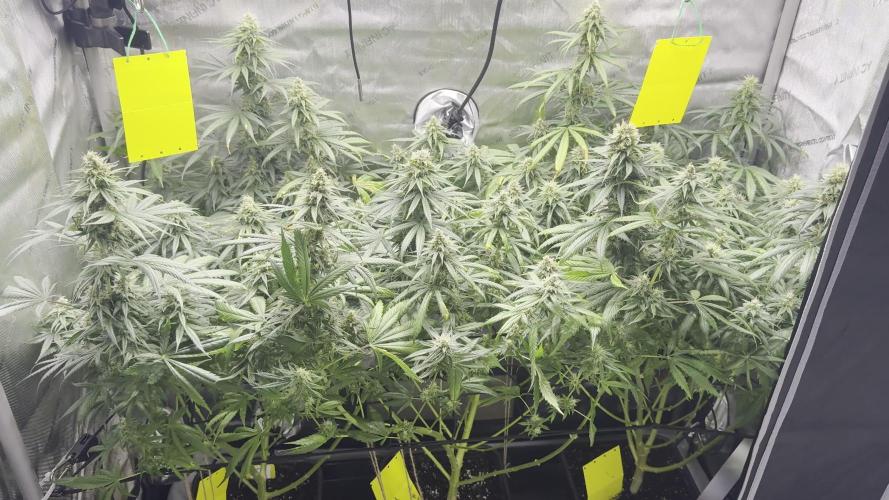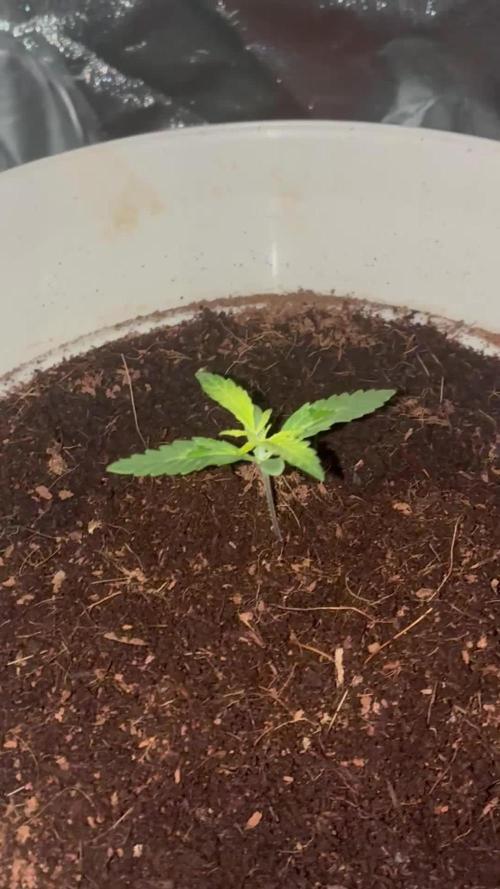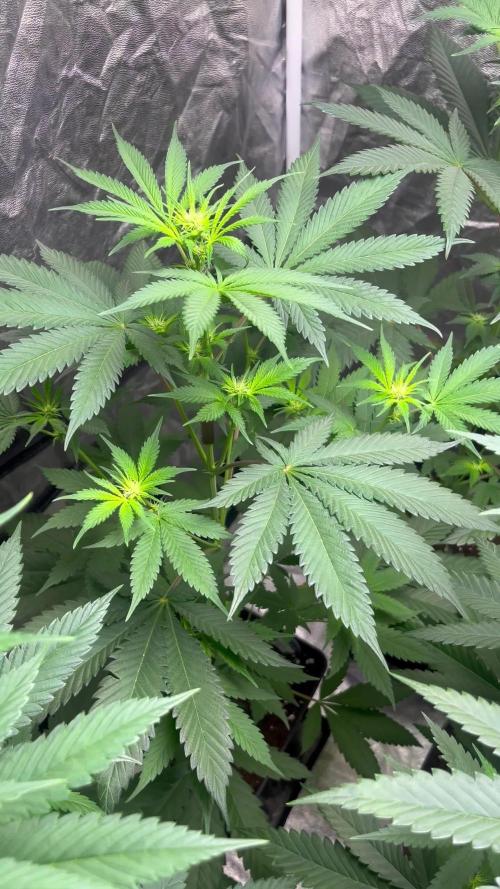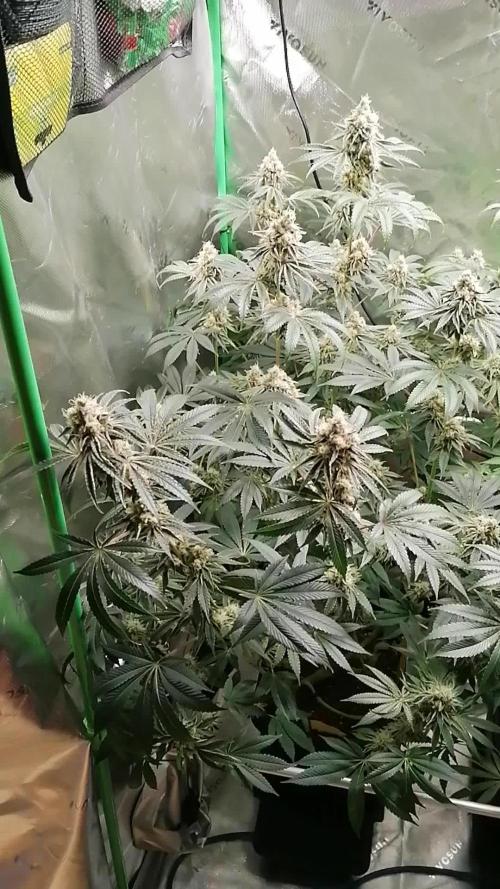The Grow Awards 2026 🏆 































Likes
14
Share


@KannaKullektiv
Follow
Sie ist soweit. Die Farbe ist intensiv und sie richt verdammt gut.
Zum schnellen trocknen im Zelt, habe Ich jeden Zweig einzeln aufgehängt und versucht die Relative Luftfeuchtigkeit zwischen 58 - 62% zu halten und die Temperatur unter 18 Grad Celsius zu bekommen.
Sobald die Stängel knacken schneide ich die Buds runter und lege sie im Zelt in Pizzakartons damit sich die Feuchtigkeit gleichmäßig verteilt.
Likes
2
Share


@Madman2020
Follow
Plants seemed close to finish so i defoliated on day 52.
The plants went through shock.
I will not be doing this again
Attempting Generative steering, i dropped humidity and allow the pots to dry out more. Watering every 2 days by hand
Likes
Comments
Share


@destroytek
Follow
Flowering Week 6 – Fading Leaves, Persistent Flies
The sixth week of flowering brought a mix of progress and persistent problems.
The whitefly issue unfortunately hasn’t gone away. I replaced both yellow sticky traps at the end of the week, and within minutes, two new whiteflies were already spotted on the fresh left trap. The old one had four additional flies on the back. This pest pressure remains a concern, but I’ve decided to hold off on further neem oil sprays for now, given how far along we are in flowering. I’ll keep monitoring closely.
Nutrient-wise, I stayed cautious this week due to ongoing signs of overfeeding. Leaf tips are still showing yellowing and some burn, especially on the lower leaves. Many leaves have pronounced yellow spots and curled tips — a clear sign of excess nutrients earlier on. To reduce stress, I watered with plain pH-adjusted water (5.5–6.0). Total watering volume was approximately 29 liters
This week I also did a second round of lollipopping, focusing on removing all small popcorn buds and lower growth under the net that wouldn’t develop well.
Despite the nutrient stress and the ongoing whitefly presence, the plants are still developing well. Buds are getting chunkier, trichome production is visibly increasing, and the overall structure is solid. Still, I’ll be keeping a close eye on both leaf health and pest activity in the coming days.
⸻
TL;DR – Week 6:
• New whiteflies still showing up – 7 total seen this week. Both sticky traps replaced.
• Additional lollipopping done: removed popcorn buds and shaded growth under SCROG.
• Leaf symptoms (tip burn, spotting) persist – watered with plain pH water, once with half HESI dose.
• Watered 3x this week: 9.5 L (pH only)
• Light stayed at intensity level 7
Likes
Comments
Share


@Noobygrower
Follow
2 week old Gorilla Z Auto looks stunted… hasnt grown much at all
Likes
18
Share


@Canadian
Follow
The plant responded very well to fim it is growing steady I wish I can leave her vegetating for another week but the other plants in my tent are growing at an incredible rate of speed so I have to rise this one in order to catch up with the rest canopy that's why I flip them to flowering schedule 12/12 I have been defoliatin in order to prepare them for maximum light penetration into the canopy for the flowering cycle .
I will continue to update thank you for reading and have a happy grow.
Likes
190
Share


@Burmese
Follow
Hi everyone, Here’s the update for week 6 along with a video.
Soil(Organic grow)
Day 35~42
She becomes alot bushy and start showing pre flowers this week.Continue LST and all going well.I just tuck-in the fan leaves under the strings.The space become so tight.You can see in my video.Most of the bud sides are visible to light.Only some are covered by fan leaves.So I am still thinking about defoliation.May I know your opinion about defoliation auto?
Here’s my nutrient solution giving for this week.
Soil
RO water
EM leaf solution- 1ml/L
Egg shell with vinegar- 0.5ml/L
Epsom salt- 1tsp/gal
pH- 6.1
ppm-200
Run off
pH- 7.0
ppm- 1300
Coco(Synthetic grow)
Day 35~42
Huuuuuh... Coco made my grow so difficult.I made alot of rotation this week.Coco #1 is now fully recovered in 1 gallon pot and Coco#2 seedling is not well.I transplant Coco #1 into 10 gallon final pot again.So it’s like 1gallon soil to 10gallon Coco.I don’t know why she can’t thrive directly in Coco/perlite mixed.She needs a bit touch of soil to recover.From now on golden days are coming.I Hope so.She will be introduced to my ScrOG soon as you can see in my video.Here’s my nutrient solution giving after transplanting.
Coco
RO water
G/M/B- 0.5ml/L
B52- 0.5ml/L
Voodoo juice- 0.5ml/L
Cal-Mag Plus- 0.5ml/L
pH- 6.2
ppm- 250
Run off
pH- 6.8
ppm- 750
Stay tune guys..
Happying growing to you all...
✌️ 🇲🇲
Likes
152
Share


@EBxAH
Follow
Week 6 started yesterday, July 11. Final step for bruce banner is now done!!! A little sloppy but whatever, lol. I'm still learning and definitely having fun 🍀😎😁👍✌️
UPDATE: July 14th, did some tie down/guiding on the sky og. Also the bruce banner is still a few days from that step but is doing quite well. They both are. Happy lady, happy life ✌️🍀
UPDATE: today is July 17th and things are going great! I added some more pics. Almost all the arms are guided to the edge for the sky og! Still a bit to go for banner though. I gotta say, this has been AMAZING to do and see for myself instead of drooling over pics on google, lol. Hope you all are having a good weekend and blessed growth ✌️🍀
Likes
71
Share


@Mosquito_Haarlem
Follow
Week 12 is begonnen.
Ze heeft niet lang meer te gaan, dus vanaf vandaag 19 juli krijgt ze alleen nog maar Spa Reine mineraalwater. Dit om overtollige metalen en mineralen weg te spoelen wat de smaak ten goede komt. It contains no carbonation and has a very low amount of minerals.
Ze ziet er echt heerlijk uit, de toppen worden zwaar en ze begint steeds meer door te leunen naar één kant. Het past allemaal net aan in de tent.
Ik zal gedurende de week nog verse foto's updaten dus hou het in de gaten 🧐
Dag 21: ik heb de hoofdstam vastgebonden want ze leunt naar een kant omdat ze te zwaar wordt.
To be continued....
Likes
7
Share


@Staffedition
Follow
Привет друзья.
Наше знакомство продолжается с новым фотоцветущим растением от Smail_Seeds сорт ORIGINAL CHEMZKITTLEZ F1 reg.
Сегодня растению 66 дней.
Перевёл на 12/12 1.10.2023
Растение очень хорошо развивается, ни каких сбоев в генетике не наблюдается😀
Сорт выводим сами.
Смотри мой профиль, у нас всегда есть что то интересное.
Не забудь поставить лайк❤️, если понравилась как прошла неделя
И читайте наш TELEGRAM: https://t.me/smail_seeds
#Smail_Seeds 😀
Likes
5
Share


@mobbly
Follow
"Hi, I received my pH meter this week, so from week 6 onwards, I'm aiming for a pH value of 6.0 - 6.5. This week, I noticed that the plant in the small pot received too much fertilizer. The other two 7.5-liter fabric pots also received double the recommended amount according to the feeding schedule, but they don't show any signs of over-fertilization."
Likes
36
Share


@PureMedicin
Follow
Had these 2 girls from a friend growing them in the window. He cannot finish them so i put them in my tent that just have finished 4 other girls the same day. Cannot wait to grow the fat banana especially.
Growing them under Mars hydro epistar 80 and added another 110 watt cfl to the grow. Doing one 12/12 from seed
They are suffering from over watering in most of veg so i am starting out with a dry period before giving them the first Bloom nutrients
Likes
2
Share


@eldruida_lamota
Follow
Vamos familia, actualizamos la segunda semana de floración de estas Gelato 44 de RoyalQueenSeeds.
La temperatura que estuvo entre los 24-26 grados y humedad dentro de los rangos correctos.
En cuanto a las plantas las veo verde sano, estiraron bien y ensancharon bastante también.
Se nota que los nutrientes de la marca Agrobeta cubre todas las necesidades de cada ejemplar.
Las flores empezaron a formarse, por el momento todo correcto, os dejé también alguna novedad y un cambio en la sala, agradecer al equipo de Mars hydro por el nuevo TSW2000. (los últimos 5 años cultive solo con los leds de esta marca)los cuales probé, TS600, TS1000, TS3000, TSL2000.
Llevaba 10 años trabajando en sodio y fue un salto de gigantes cambiar a los Leds, jamás me arrepentiré de ese cambio.
- os dejo por aquí un CÓDIGO: Eldruida
Descuento para la tienda de MARS HYDRO.
https://www.mars-hydro.com
Hasta aquí todo, Buenos humos 💨💨💨
Likes
16
Share


@Marsledgrower
Follow
Looking great continue to put on a little weight. Im in for the ride in this one ..
being patient and letting the plants do their thing.
Likes
5
Share


@Ninjabuds
Follow
7 archive seeds are legit super dense tricomb production like nothing I've seen b4. I would NEVER BUY SEEDS FROM ARCHIVESEEDBANK.COM.... they have great genetics but there customer service is garbage. This summer I spent 50 on these 3 seeds and 125 on a 12 pack of reg seeds of a diff strain the reg seeds didn't grow at all and archive never responded they sold me old ass seeds and stole my 125$ I'm happy I already got 32 seeds from the crappy plant of the 3 that I already cut down. I'm letting the last 2 finish up completely
Likes
92
Share


@Cannibalgardens
Follow
Well to say I am happy about this girl would be a understatement . She was so good and even though I neglected her for a while she was so good to me with the harvest . The team at dinafem have outdone them selves with this strain I had hot, humid,wet ass conditions for a month and she was strongest plant out doors I had .. Very resilient and good for that kind of climate Canadian wet weather she was the queen and I will grow her again ...The thing is if I had taken better care of her lack of time she was out of the way ,then the amount I would have right now would be crazy next year I'll try again lol cheers and thanks canna family so much follow along on instagram @cannibal19888
Likes
38
Share


@Brujha77
Follow
Beginn 8. Blütewoche
Langsam kommt der Endspurt.
Schätze mal noch 2 bis max. 3 Wochen dann sollten die 3 es geschafft haben.


























